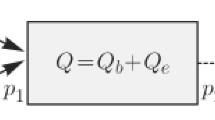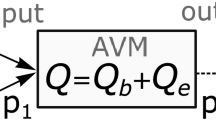Abstract
Bypass surgery is widely used in the treatment of cardiovascular diseases. The problem of optimal location of cerebral vascular anastomosis is considered. An electrical analogue of circulation in major cerebral vessels is constructed whose optimal parameters are determined numerically using swarm intelligence methods. The objective optimization function is taken to be the pressure after shunting compared with the pressure before surgery. This method is first used to solve the problem of the formation of cerebral vascular bypasses. It is shown that the obtained results are in good agreement with the data of real surgeries.




Similar content being viewed by others
REFERENCES
N. El. Khatib, O. Kafi, A. Sequeira, et al., “Mathematical Modeling of Atherosclerosis," Math. Modell. Natur. Phenomena 14 (6), 603 (2019).
I. I. Tagiltsev and A. V. Shutov, “Geometrically Nonlinear Modeling of Pre-Stressed Viscoelastic Fiber-Reinforced Composites with Application to Arteries," Biomech. Model. Mechanobiol. 20, 323–337 (2021).
Yu. O. Kuyanova, S. C. Presnyakov, A. V. Dubovoi, et al., “Numerical Study of Tee Hydrodynamics in the Model Problem of Optimizing the Low-Flow Vascular Bypass Angle," Prikl. Mekh. Tekh. Fiz. 60 (6), 72–80 (2019); [J. Appl. Mech. Tech. Phys. 60 (5), 1038–1045 (2019); DOI; 10.1134/S0021894419060087].
S. S. Simakov, “Modern Methods of Mathematical Modeling of Blood Flow Using Reduced Order Methods," Comput. Res. Model. 10 (5), 581–604 (2018).
J. R. Cebral, F. Mut, D. Sforza, et al., “Clinical Application of Image-Based CFD for Cerebral Aneurysms," Intern. J. Numer. Methods Biomed. Engng. 27 (7), 977–992 (2010).
Yu. V. Vassilevski, V. Yu. Salamatova, and S. S. Simakov, “On the Elasticity of Blood Vessels in One-Dimensional Problems of Hemodynamics," Comput. Math. Math. Phys. 55 (9), 1567–1578 (2015).
T. W. Peach, M. Ngoepe, K. Spranger, et al., “Personalizing Flow-Diverter Intervention for Cerebral Aneurysms: from Computational Hemodynamics to Biochemical Modeling," Intern. J. Numer. Methods Biomed. Engng. 30 (11), 1387–1407 (2014).
S. S. Simakov, A. E. Timofeev, T. M. Gamilov, et al., “Analysis of the Impact of Left Ventricular Assist Devices on the Systemic Circulation," Russ. J. Numer. Anal. Math. Modell. 35 (5), 295–314 (2020).
J. Kennedy and R. Eberhart, “Particle Swarm Optimization," in Proc. of the Intern. Conf. on Neural., Perth (Australia), Nov. 27 — Dec. 1, 1995 (IEEE Service Center, Piscataway, 1995), Vol. 4, pp. 1942–1948.
M. Ursino and M. Giannessi, “A Model of Cerebrovascular Reactivity Including the Circle of Willis and Cortical Anastomoses," Annals Biomed. Engng. 38 (3), 955–974 (2010).
M. Abdi, A. Karimi, M. Navidbakhsh, et al., “Modeling the Circle of Willis Using Electrical Analogy Method under Both Normal and Pathological Circumstances," J. Biomed. Phys. Engng. 3 (2), 45–56 (2013).
S. I. Kuznetsov, A Course in Physics with Examples of Problem Solving, Ch. 2 (Tomsk Polytechnic University, Tomsk, 2013) [in Russian].
H. Matsukawa, Sh. Miyata, T. Tsuboi, et al., “Rationale for Graft Selection in Patients with Complex Internal Carotid Artery Aneurysms Treated with Extracranial to Intracranial High-Flow Bypass and Therapeutic Internal Carotid Artery Occlusion," J. Neurosurgery. 128, 1753–1761 (2017).
R. Poli, J. Kennedy, and T. Blackwell, “Particle Swarm Optimization," Swarm Intelligence, No. 1, 33–57 (2007).
Author information
Authors and Affiliations
Corresponding author
Additional information
Translated from Prikladnaya Mekhanika i Tekhnicheskaya Fizika, 2021, Vol. 63, No. 4, pp. 64-72. https://doi.org/10.15372/PMTF20220407.
Rights and permissions
About this article
Cite this article
Kuyanova, Y.O., Dubovoi, A.V., Bervitskii, A.V. et al. NUMERICAL OPTIMIZATION OF GEOMETRIC CHARACTERISTICS OF VASCULAR BYPASS USING SWARM INTELLIGENCE METHODS IN NEUROSURGERY. J Appl Mech Tech Phy 63, 606–613 (2022). https://doi.org/10.1134/S0021894422040071
Received:
Revised:
Accepted:
Published:
Issue Date:
DOI: https://doi.org/10.1134/S0021894422040071




